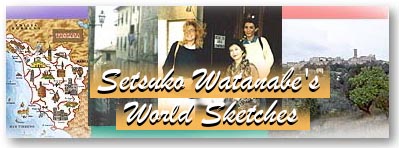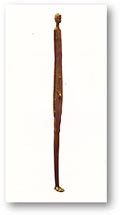 The Mysterious Town of Volterra and Evening Shadow (Tuscany) |

|
I had been thinking I'd like to visit Volterra. After reading D.H. Lawrence's Etruscan Places, I became interested in Etruscan culture. And when I saw Evening Shadow in an art magazine, I was intrigued by the long, thin, bronze statue and its title. Also, my son's friend was living there. All these reasons led to my taking a trip to Volterra.
I stayed overnight on a farm in the suburbs. In the mornings and evenings, I looked up at the city. At dawn, when the sun rises in the sky, the city begins to appear. The evening sun sets on the gentle hills and the sky changes from a golden color, to dark red, then dusky purple and finally jet black. For 2,000 years, the eternal fortress has continued to watch over the Tuscany hills, valley and people. At night, it is lit up and looks like a castle in the air. In Tuscany, the wind always blows calmly. Wilted leaves, sand dust, and sometimes, the musty smell from the coffins of the Etruscans, together with the smell of sheep, are carried in the air. At the museum, encircled by the cinerary urns of the Etruscans, who entrusted their dreams to the after world rather than reality, you dissolve into the world of the dead. On the lids of the urns, made from the locally manufactured alabaster and terra-cotta, images of the deceased sitting with their legs folded to the side and many everyday objects have been carved with all the heart and soul of the carvers. From the various carvings which tell of the everyday life of the deceased and from their gentle expressions, we can imagine their peaceful and rich life. Women, in particular, seemed to have lived fully, without suppression. A scene of an old couple sitting together carved on the terra-cotta lid (1st century B.C.) was very striking.
Evening Shadow was on lease to a museum in the United States and in its place was a life-sized replica. Coming to this town where long shadows fall on the castle walls at sunset, I understood a little how the artist felt. Was this an expression of the artist's own shadow on the castle wall at dusk? Was it a carving of travelers hurrying to the castle gate at dusk? It shows the mixture of awe and fear toward the coming night. This statue is the city symbol and can be found decorating every show window. In the distant past of over 2,000 years ago, who on earth created such a modern statue and for what reason? The faces on three sides of the Volterra entrance arch (4th century B.C.) are corroded, so we can't even imagine what kind of statues were carved there in the past. What kind of faces did they have and what roles did they play? The Etruscans were conquered by the Romans in the first century. Their highly artistic civilization was envied by the Romans and completely destroyed. Therefore, there are many puzzles of the Etruscan culture, which may be the reason why they call this place the mysterious Volterra. The mysterious parts stir my imagination.
Links
Copyright1998 Setsuko Watanabe
|
- back to home -

